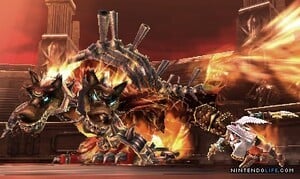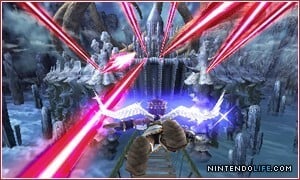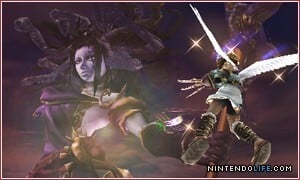
As its sequel itself is keen to point out in a tongue-in-cheek manner, it's been 24 years since Pit flapped his wings up, up and away in his nail-biting platform debut Kid Icarus. The NES original cribbed the best bits of franchises like Super Mario Bros., The Legend of Zelda and Metroid and crafted an ambitious, albeit flawed, little cult gem.
In our hands-on with the game in New York City and Amsterdam last week, we weren't really surprised to see that 24 years later, the series is lifting the best bits from another franchise for half of its gameplay: the forward-moving airborne portions of Treasure's Sin and Punishment: Star Successor. Or, if your gaming vocabulary is a bit more old-school, Space Harrier.
Subscribe to Nintendo Life on YouTube841k
Our demo included two portions of the game: one labeled Easy from early on in the adventure, and another dubbed Hard that occurs further in. We zoomed into Easy first to get a good feel for the controls before jumping into further slaughter, and it wasn't long before we found ourselves barreling through the air and blasting baddies out of the sky. Before we began, we were prompted to choose one of three weapons to bring into battle, with a sword acting as the all-around type and two others balanced for melee strikes and rapid fire.

There are two types of play in Uprising: up in the air and down on land. The opening stage starts off in the sky with our boy Pit bantering back and forth with the goddess Palutena as she explains how to maneuver, target and fire upon Medusa's minions. While flying, players can only move Pit along the X and Y axes using the Circle Pad, as Palutena propels you forward — but only has the power to do so for up to five minutes at a time, apparently. Aiming is done with the stylus and holding the L button allows continuous fire, or if you're up close and personal will trigger a melee attack. A large circle surrounding your reticule indicates whether you have a charge shot ready, which is automatically fired upon first blast and recharged by resting that trigger.
Up in the air, Pit controls like a dream: it's very easy to zip about with the Circle Pad and take down targets by aiming with the stylus once you're accustomed to holding the 3DS in a claw-like manner in one hand (just like for any DS first-person shooter), and the depth granted by the stereoscopic effect really makes enemies pop and the looming sky look endless. We'd be pretty happy if Uprising called it a day with only air battles, but they're only half the package. The other half, unfortunately, isn't quite as tight.
Eventually Pit's flight path takes him down to a courtyard in front of a temple that housed a mean-looking-but-marshmallow-y fire dog thing, and it's here where Uprising gets a little hairy. Masahiro Sakurai is the mastermind behind both Nintendo's fighter series as well as Uprising, and it's very evident in how Pit handles. The Circle Pad controls his full ground movement, with quick Super Smash Bros. Brawl-style slams used to pull off dodges. The stylus still handles aiming, but the game runs into a problem that many first-gen Wii shooters ran into: the dead zone for aiming is far too large for quick movements, as you turn much too slow. There is a quick-pivot accomplished by swiping the stylus in the desired direction and then tapping the screen again when you want him to stop, but it's a little hokey and feels like a weird bandage over a larger sore. Another oddity relates to the camera itself: we noticed it jerked slightly towards enemies as an auto-lock, but it sometimes got in the way of us just turning our viewpoint. Perhaps these things are something that require more time with than we were afforded to get used to, but the land portions left us a little cold.

Pit looks strikingly similar to his Wii appearance in Smash Bros. Brawl and the world follows a similarly thematic suit. It's a very appealing style, with lots of smooth and round surfaces that work quite well in 3D. As is the case in other games we tested, a little went a long way for the stereoscopic effect. While the screens stay relatively clutter-free and thus avoid the pitfall of having too much to focus on, we found little benefit in cranking the 3D volume slider very high as it tended to look a little over-focused around the edges of the screen.
In our time with it, Kid Icarus: Uprising played nothing at all like the franchise's other two decades-old games, but that's not necessarily a bad thing in this case. The game was easily one of the playable highlights of the event and is one to keep your eye (or two) on down the line when it eventually releases sometime in the 3DS's eight-week launch window.
Comments 43
This will be the best Kid Icarus game.
Or will it?
"it's a trap!" XD
I wish they could release this at launch.
The controls are a major turn-off for lefties...
Getting this day one. Only thing i'm worried about is the use of the L & R buttons and the sensitivity of turning while on the ground.
This is the 3DS game I'm the most excited for! I'm so glad kid Icarus is getting a squeal.
Nice to hear some impressions for the game.(thank you!) Glad to hear controls are nice and responsive for flying. Hopefully the ground controls will be improved by launch. Although they don't sound like too much of a bother to me. I'm really dieing to see the 3D in this! I can only imagine how amazing it'll be when flying.
Well only around 4 more months, can't wait!
I'm a fan of the original Kid Icarus and I'm glad this one is getting a good early buzz. I do enjoy StarFox at its best (haven't gotten to S&P) but it's a bit of a shame that the traditions of the first weren't carried forward somewhat.
The original Kid Icarus was indeed a flawed (and brutal) game but it excelled in many ways and had its own unique feel. Borrowing from the 3 greatest franchises at Nintendo and keeping its own identity isn't a bad thing and I wish it could continue that.
Maybe this one will rock some sales and sequels will draw the gameplay towards its roots a bit more. One can dream.
I'm Surprised To Hear You Guys Think The Controls Are Great. The Majority of Sites Said They FElt Cramped And Aiming Using The Touch Screen Was A Pain. I Guess It Is Just A Matter Of Opinion.
I want this so bad. Great impressions guys.
@ballkirby1: I think we've played more DS shooters on average than other sites. I reviewed 3 DS FPS within a month this past holiday so I'm pretty used to the claw hand.
Really looking forward to this one. The bounding box issue seems like an easy fix for Nintendo, so hopefully they'll be able to polish it up a bit before it launches. Nice article, Jon
Happy they are reviving the Kid Icarus series since brawl
I played the 1st one on VC it was hard
Since it's not going to make launch anyway, I hope they take their time with it and make it kick major bootie.
It looks good, but it will be on my if there is nothing else to play list. Somthing about it just isnt clicking with me.
Sounds like a game I would get used.
Why on earth are they using a deadzone/pivot type aiming system instead of a 1:1 setup like any DS shooter? It's FAR more accurate and responsive!
Also I don't understand why people complain about stylus aiming. It is not that difficult.
Err... Any chance someone could explain what this "deadzone" thing is? :S I'm not big on FPS games so I have no idea what a '1:1 setup' is either... But in any case this looks like it's going to be truly awessome
"Up in the air, Pit controls like a dream: it's very easy to zip about with the Circle Pad and take down targets by aiming with the stylus"
Yeah, if you're right-handed. It's a shame a lefty didn't try out the game. I'm sure I'll "get used to it" over time, but there will probably be some spots in the game requiring quick reflexes I'll be screwed on. Whatever, I'll try it out in the store at release, and if it's how I think it will be, I won't buy the game no matter how good it is.
Kid Icarus aka Sin & Punishment aka REZ aka Panzer Dragoon aka Space Harrier aka I'm probably missing a few. I'm a sucker for this kind of game, and I'm hoping the 3D makes it easier to gauge distances on incoming projectiles (which would have been especially nice in Sin & Punishment). I played the hell out of the Gameboy version of the original, so count me in the group of people who have been patiently waiting forever for a sequel.
Sounds pretty cool. .FT.
@WiiLovePeace
Deadzone = the area the crosshair moves in before your character starts to turn.
1:1 setup = when the crosshair is locked in the center of the screen, ala Halo/any PC FPS.
Require a review. I don't normally go for handheld fps or third person view shooter style games. In the end I suspect I'll get this
Touch screen aiming = super and I expect great things from 3DS as a FPS console. DS had exellent, very, very mouse like FPS controls, but 3DS also has analogue controller and great graphics in 3d. I wonder why theyre using dead zone though!?!?!? Sounds sucking. I hope there is customization options in the finnished game then, so that we can get rid of any brain farts, they might be having with the controls.
I just wish they wouldn't have forgotten the admittedly hard to market thumbstrap. Thumbstrap FTW!!! Bring it back.
I believe that first sentence should say "it's been 24 years since Pit flapped his wings up, up and realized he couldn't fly on his own" Poor guy
Anyways, the game looks awesome
I had a feeling the controls on the ground would be a little odd, hopefully Nintendo will do something to make the ground levels a bit more enjoyable in the complete version.
Controls might be a little tough for lefties like me, but I'll manage.
@Jon Wahlgren
What does the claw hand look like?
This game looks awesome!!! Hopefully they'll improve the ground level controls before release.
@retro_on_thego Welcome to nl.
@lex0plex: It's when you're trying to support the (3)DS with only your left hand, resting one finger on the L button and your thumb on the Circle/D-Pad. The other hand is pressing against the touchscreen with the stylus, causing the left wrist to sometimes cramp up if you're not used to it. Definitely not the most comfortable of positions, but you can get around the cramping if you rest the handheld on your leg or other surface.
I am also in a precarious situation, as I feel that this game was design to be the 3DS' killer-app, but I am left-handed and am worried about using
my right-hand to aim. Why Nintendo didn't put a second circle-pad in below the face buttons still boggles me. Cost be damned, functionality should be priority #1.
@Panda: i'm having flashbacks to Phantom Hourglass already D:
Are there any alternate control schemes?
Hmm, not convinced by this one yet. The controls sound awful , appartley the ground based combat is a bit sucky and the enemy art looks very generic. I'll keep an eye out when the reviews start flooding in but at the moment I'm failing to see why people are getting excited about this. (Though I'll admit that until Super Smash Bros I had no idea who Pitt was but that NES game looks awful!)
@4. i'm sure they'll have options to change the controls for lefties.
Dude Kid Icarus sucks butnow it's gonna rock! It'll be funny if it's rated T. [=
Looks like it will be one of the greatest 3DS games ever although I hope it's not as unplayable as Metroid Prime Hunters on DS.
^Metroid on DS is severely playable. Also one of the most meanigfull first posts ever... Dual analog lobbying has started. What ever the lobbyists say, touch screen aiming > dual analog clumsiness, that makes game characters look like robocops with crowbars in their .
@33 Check this out okay... Go pick up your DS right now. Hold the left side in your left hand, the stylus in your right, and then... support the right side of the console with the rest of your right hand. Whoaa. I actually like playing Hunters reclined on my bed, with the DS resting on my front, and just slip my right pinky behind the top half of the DS to comfortably support it.
@40 A little part of me inside dies every time I hear someone say that Metroid Prime Hunters is unplayable.
Yes. That works very, very well.
But! Heres a Pro tip:
http://members.arstechnica.com/x/drfaulken/thumbStrap.jpg
Not everyone knows, that thumb strap came with original DS Phat package, but it was quickly forgotten, perhaps for it stupid look, but never mind the looks. Try it, it IS BRILLIANT!!!!
Mod it thusly:
http://t0.gstatic.com/images?q=tbn:ANd9GcQK1DhkdxDRZYRFqmaHeKDkxLyyPw9dkHv7cNmdyQDYYBD7aY6N4Q
It makes separate touchscreen a kind of dual analog -like, but retains all the accuracy, speed and precission of a mouse.
@Jon
Ok that doesn't sound so bad... I was thinking of the PSP claw hand for monster hunter where you have to control the circle pad with your thumb and the d-pad with your first finger. I was worried that the 3ds would have this issue as soon as I saw that there was a circle pad. But like I said, this really doesn't seem that bad - easy to get used to!
http://boards.hunterchan.org/psp/src/128092372084.png
edit: the 3ds looks waaaay more comfy than this! ^
@43 that doesnt look so precise, there is a flexible stylus that u can wrap around your thumb too, but there was also a strap for your thumb that had a little space for your thumb to press buttons while wearing it http://www.daydeal.com/product.php?productid=16138&cat=2654
it'll play like a dream when it gets here. speaking of which...
Really excited
Show Comments
Leave A Comment
Hold on there, you need to login to post a comment...